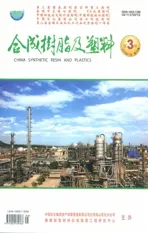新型铁配合物催化乙烯齐聚的研究
2016-06-06郑明芳王怀杰张海英中国石油化工股份有限公司北京北化院燕山分院北京市102500
郑明芳,刘 珺,王怀杰,张海英(中国石油化工股份有限公司北京北化院燕山分院,北京市 102500)
新型铁配合物催化乙烯齐聚的研究
郑明芳,刘 珺,王怀杰,张海英
(中国石油化工股份有限公司北京北化院燕山分院,北京市 102500)
摘 要:以合成的新型铁配合物——氯化2-正丁酰基-1,10-菲咯啉缩2,6-二乙基苯胺合铁(Ⅱ)为主催化剂,分别以甲基铝氧烷(MAO)、改性MAO(MMAO)、三乙基铝(TEAL)为助催化剂,催化乙烯齐聚。结果表明:相同条件下,以MAO或MMAO为助催化剂的催化剂活性远高于TEAL作助催化剂;以MMAO为助催化剂时,随n(Al)∶n(Fe)的增大,催化剂活性呈先升高后降低的趋势,n(Al)∶n(Fe)为800时,催化剂活性最高,为3.37×107g/(mol·h);随反应温度的升高,催化剂活性下降,产物分布向低碳数方向移动;随反应压力提高,催化剂活性升高,产物分布也向低碳数方向移动。
关键词:乙烯齐聚 铁配合物 α-烯烃 齐聚产物
α-烯烃是重要的有机化工原料,广泛应用在聚烯烃、增塑剂、合成润滑油和油品添加剂等领域。目前,α-烯烃的生产方法主要是乙烯齐聚法,除乙烯三聚工艺能够选择性地生成1-己烯外[1],其他齐聚工艺(如美国雪佛龙菲利普斯化工公司的Ziegler工艺[2]、荷兰Shell公司的SHOP工艺[3])生产的都是C4~C30的α-烯烃。
1998年,Brookhart等[4-5]发现了一类新型三齿氮结构的吡啶基二亚胺类铁(钴)烯烃聚合催化剂后,很多学者通过对配体结构的修饰不断丰富着这个新家族[6-9],并试图建立配体结构变化与催化剂活性之间的关联关系[10];但开发具有高活性的铁配合物仍然是人们追求的目标[6-7,11]。2006年,Sun Wenhua等[12-15]合成的2-亚胺-1,10-菲咯啉基铁配合物[见图1a,R'为氢、甲基或苯基(Ph),R1为甲基、乙基或异丙基]催化乙烯齐聚时表现出很高的活性,采用不同亚胺基对催化剂活性的影响由小到大依次为醛基、苯酰基、乙酰基。随后合成的丙酰基铁配合物[16](见图1a,其中R´为乙基)催化乙烯齐聚的活性虽然不如乙酰基,却表现出更好的热稳定性和对C6~C16α-烯烃更高的选择性。因此,为探寻更好的乙烯齐聚催化剂并总结规律,本工作合成了新型铁配合物——氯化2-正丁酰基-1,10-菲咯啉缩2,6-二乙基苯胺合铁(Ⅱ)(见图1b),并进行了乙烯齐聚的考察。

图1 催化剂结构Fig. 1 Modified catalyst models
1 实验部分
1.1主要试剂与仪器
乙烯,聚合级,中国石油化工股份有限公司北京燕山分公司生产,未经处理直接使用。助催化剂甲基铝氧烷(MAO),配制成浓度为1.46 mol/ L的甲苯溶液;助催化剂改性MAO(MMAO),配制成浓度为1.88 mol/L的正庚烷溶液:均为美国Albemarle公司生产。助催化剂三乙基铝(TEAL),质量分数为95%,南京通联化工有限公司生产。FeCl2·4H2O,分析纯,北京双环化学试剂厂生产。甲苯、四氢呋喃:均为分析纯,北京化工厂生产,氮气保护下加入金属钠回流,使用前蒸出。
DMX400型核磁共振仪,德国Bruker公司生产;HP-5971型质谱仪,美国惠普公司生产;7890A型气相色谱仪,美国安捷伦公司生产。
1.2新型铁配合物的制备
配体2-正丁酰基-1,10-菲咯啉缩2,6-二乙基苯胺按照文献[17]方法合成。
配体的核磁共振氢谱(溶剂为氘代氯仿):化学位移为9.25[双二重峰,耦合常数(J)=2.96,1H],8.66(二重峰,J=8.36,1H),8.33(二重峰,J=8.36,1H),8.28(双二重峰,J=7.84,1H),7.85(双二重峰,J=9.02,2H),7.65(双二重峰,J=4.36,1H),7.15(二重峰,J=7.52,2H),7.06(三重峰,J=7.04,1H),3.01(三重峰,J=7.84,—COCH2—),2.53(多重峰,J=7.56,PhCH2—),2.40(多重峰,J=7.52,PhCH2—),1.58(多重峰,J=7.44,CH3CH2—,2H),1.20(三重峰,J=7.30,PhCH2CH3,6H),0.90(三重峰,J=7.32,CH3CH2CH2—,3H)。
元素分析计算值:w(C)=81.85%,w(H)= 7.13%,w(N)=11.01%;元素分析测量值:w(C)= 81.64%,w(H)= 7.20%,w(N)=10.55%。
配体与等物质的量的FeCl2·4H2O在四氢呋喃中反应,过滤,得到新型铁配合物。
1.3乙烯齐聚
在300 mL不锈钢高压釜中进行乙烯齐聚,高压釜经加热抽真空、氮气置换数次后充入乙烯,降温至预定温度,依次加入定量的甲苯、助催化剂、新型铁配合物的甲苯溶液,在设定的温度和压力下反应。反应结束后在冰浴中迅速降温、卸压,用质量分数为5%的酸化乙醇终止反应后进行定量分析。
2 结果与讨论
2.1助催化剂对乙烯齐聚的影响
目前,MAO与MMAO(通常含有质量分数为20%~25%的三异丁基铝)仍然是2-亚胺-1,10-菲咯啉基铁或钴配合物催化乙烯齐聚最常用的助催化剂。MAO是三甲基铝部分水解的产物,从表面看,反应原理十分简单,但由于铝原子的缺电子性,使MAO的组成及结构复杂。因此,MAO很可能是线型结构、环状结构、簇状结构的混合物[18]。
以新型铁配合物为主催化剂,分别以MMAO,MAO,TEAL为助催化剂进行乙烯齐聚。从表1可以看出:以MAO或MMAO为助催化剂时的催化剂活性远高于TEAL。以TEAL为助催化剂,催化剂活性均小于1.00×106g/(mol·h)。MMAO用量对催化剂活性的影响也很显著,n(Al)∶n(Fe)为800时,催化剂活性最高,为33.7×106g/(mol·h)。作为助催化剂,MMAO不仅帮助产生活性物种,还起到清杂的作用,即清除溶剂或原料中的杂质。因此,MMAO少量过量对反应有利,然而,过量太多,n(Al)∶n(Fe)大于800后,催化剂活性下降,是由于异丁基会影响乙烯的插入所致[19-20]。MAO用量对催化剂活性的影响与MMAO类似,n(Al)∶n(Fe)为1 000时,催化剂活性最高,为38.7×106g/(mol·h)。
K值可以表征齐聚产物的分布情况,K值随催化剂种类、反应条件的变化而变化。其计算公式为:K=链增长速率/(链增长速率+链转移速率)=Cn+2的物质的量/Cn的物质的量=C14的物质的量/C12的物质的量(通常)[21-22]。从表1还可以看出:无论是MMAO还是MAO作助催化剂,随着n(Al)∶n(Fe)的增加,对α-烯烃的选择性均没有明显的影响,但K值呈先增长后降低的趋势,即产物分布先向高碳数方向移动再向低碳数方向移动。这是由于链增长速率和链转移速率的变化不同所致。

表1 不同助催化剂对乙烯齐聚的影响Tab. 1 Effect of different cocatalysts on ethylene oligomerization
2.2反应温度对乙烯齐聚的影响
主催化剂用量为1 μmol,MMAO为助催化剂,甲苯溶剂用量为100 mL,n(Al)∶n(Fe)为800,反应压力为1.0 MPa,反应时间为30 min。从表2可以看出:随着反应温度的升高,催化剂活性下降,K值减小。这说明尽管升高温度能提高链增长和链转移速率,但链转移速率的增长幅度较链增长速率大,所以低碳数的烯烃成为主要产物。温度升高,催化剂活性呈下降趋势则是两个因素共同作用的结果[23]:一方面,温度升高导致乙烯在溶剂中的浓度降低;另一方面,温度升高,增加了活性中心的失活速率,导致活性下降。

表2 反应温度对乙烯齐聚的影响Tab. 2 Effect of reaction temperature on ethylene oligomerization
2.3反应压力对乙烯齐聚的影响
主催化剂用量为1 μmol,MMAO为助催化剂,甲苯溶剂用量为100 mL,n(Al)∶n(Fe)为800,反应温度为40 ℃,反应时间为30 min。从表3可以看出:随着反应压力增加,催化剂活性逐渐升高。这是因为反应压力增加,体系中的乙烯单体浓度增大,使链增长和链转移速率加快,因此催化剂活性升高[24-25]。因链转移速率增长幅度较链增长速率大,所以齐聚产物向低碳数方向移动。从表3中还可以看出:随着压力的增加,α-烯烃的选择性提高。这是因为低压时,与活性物种配位的乙烯相对较少,在乙烯发生配位进行链转移之前,较多的活性物种就发生了β-H消除反应,因此会产生带支链的齐聚物;而当压力较高时,乙烯配位发生在β-H消除反应之前,β-H直接向配位乙烯的转移能产生更多的α-烯烃。

表3 反应压力对乙烯齐聚的影响Tab. 3 Effect of reaction pressure on ethylene oligomerization
3 结论
a)新型铁配合物——氯化2-正丁酰基-1,10-菲咯啉缩2,6-二乙基苯胺合铁(Ⅱ)在助催化剂MMAO的作用下,用于乙烯齐聚表现出很高的活性而且对α-烯烃具有很好的选择性。
b)MAO,MMAO为助催化剂时,催化剂的活性相当,而TEAL作助催化剂时,催化剂的活性相对较差。
c)反应温度、反应压力和n(Al)∶n(Fe)对催化剂活性和产物分布均有较大影响。
4 参考文献
[1] Reagen W K,Conroy B K. Chromium compounds and uses thereof :US,5288823A[P].1994-02-22.
[2] Zieger K,Martin H. Production of dimers and low molecular polymerization products from ethylene: US,2943125A[P].1960-06-28.
[3] Keim W,Kowaldt F H,Goddard R,et al. α-amino acids as nucleophilic acyl equivalents:synthesis of ketones and aldehydes using oxazolin-5-ones[J]. Angew Chem,1978,90 (6):493-495.
[4] Small B L,Brookhart M,Bennett A M A. Highly active iron and cobalt catalysts for the polymerization of ethylene[J]. J Am Chem Soc,1998,120(16):4049-4050.
[5] Britovsek G J P,Gibson V C,Kimberley B S,et al. Novel olefin polymerization catalysts based on iron and cobalt[J]. Chem Commun,1998(7):849-850.
[6] Ma Jing,Feng Chun,Wang Shaoli,et al. Bi- and tri-dentate imino-based iron and cobalt pre-catalysts for ethylene oligo-/ polymerization[J]. Inorg Chem Front,2014,1(1):14-34.
[7] Zhang Wen,Sun Wenhua,Redshawa C. Tailoring iron complexes for ethylene oligomerization and/or polymerization[J]. Dalton Transactions,2013,42(25):8988-8997.
[8] Ittel S D,Johnson L K,Brookhart M. Late-metal catalysts for ethylene homo- and copolymerization[J]. Chem Review,2000,100(4):1169-1203.
[9] Bianchini C,Giambastiani G,Rios I G,et al. Ethylene oligomerization,homopolymerization and copolymerization by iron and cobalt catalysts with 2,6-(bis-organylimino)pyridyl ligands coord[J]. Chem Review,2006,250(11/12):1391-1418.
[10] Gibson V C,Redshawa C,Solan G A. Bis(imino)pyridines: surprisingly reactive ligands and a gateway to new families of catalysts[J]. Chem Review,2007,107(5): 1745-1776.
[11] Small B L,Rios R,Fernandez E R,et al.Oligomerization of ethylene using new iron catalysts bearing pendant donor modified α-diimine ligands[J]. Organometallics,2007,26(7):1744-1749.
[12] Sun Wenhua,Jie Suyun,Zhang Shu,et al. Iron complexes bearing 2-imino-1,10-phenanthrolinyl ligands as highly active catalysts for ethylene oligomerization[J]. Organometallics,2006,25(3):666-677.
[13] Wang Leyong,Sun Wenhua,Han Lingqin,et al. Late transition metal complexes bearing 2,9-bis(imino)-1,10-phenanthrolinyl ligands: synthesis,characterization and their ethylene activity[J]. J Organomet Chem,2002,658(1/2):62-70.
[14] Sun Wenhua,Tang Xiubo,Gao Tielong,et al. Synthesis,characterization,and ethylene oligomerization and polymerization of ferrous and cobaltous 2-(ethylcarboxylato)-6-iminopyridyl[J]. Complexes Organometallics, 2004,23(21):5037-5047.
[15] Jie Suyun,Zhang Shu,Sun Wenhua,et al. Iron(Ⅱ) complexes ligated by 2-imino-1,10-phenanthrolines: preparation and catalytic behavior toward ethylene oligomerization[J]. J Mol Catal A:Chem,2007,269(1/2):85-96.
[16] Zhang Min,Zhang Wenjuan,Xiao Tianpengfei,et al. 2-ethylketimino-1,10-phenanthroline iron(Ⅱ) complexes as highly active catalysts for ethylene oligomerization[J]. Journal of Molecular Catalysis A: Chemical,2010,320(1/2):92-96.
[17] 刘珺,郑明芳,王怀杰,等. 丁酰基取代的1,10-菲咯啉配合物的制备方法及由此制备的配合物作为乙烯齐聚催化剂的应用:中国,102485732B[P]. 2015-01-14.
[18] Glaser Rainer,Sun Xinsen. Thermochemistry of the initial steps of methylaluminoxane formation. Aluminoxanes and cycloaluminoxanes by methane elimination from eimethylaluminum hydroxide and its dimeric aggregates[J]. J Am Chem Soc,2011,133(34):13323-13336.
[19] Chen E Y X,Marks T J. Cocatalysts for metal-catalyzed olefin polymerization: activators,activation processes,and structure-activity relationships[J]. Chem Review,2000,100 (4): 1391-1434.
[20] Karam A R,Catarı' E L,Lo'pez-Linares F,et al. Synthesis,characterization and olefin polymerization studies of iron(Ⅱ) and cobalt(Ⅱ) catalysts bearing 2,6-bis(pyrazol-1-yl)pyridines and 2,6-bis(pyrazol-1-ylmethyl)pyridines ligands[J]. Appl Catal A: Gen,2005,280(2):165-173.
[21] Meurs M V,Britovsek G J P,Gibson V C,et al. Polyethylene chain growth on zinc catalyzed by olefin polymerization catalysts: a comparative investigation of highly active catalyst systems across the transition series[J]. J Am Chem Soc,2005,127(27): 9913-9923.
[22] Britovsek G J P,Cohen S A,Gibson V C,et al. Iron catalyzed polyethylene chain growth on zinc: a study of the factors delineating chain transfer versus catalyzed chain growth in zinc and related metal alkyl systems[J]. J Am Chem Soc,2004,126 (34): 10701-10712.
[23] Britovsek G J P,Mastroianni S,Solan G A,et al. Oligomerisation of ethylene by bis(imino)pyridyliron and -cobalt complexes[J]. Chem Eur J,2000,6(12):2221-2231.
[24] Jie Suyun,Zhang Shu,Sun Wenhua. 2-arylimino-9-phenyl-1,10-phenanthrolinyl-iron,-cobalt and -nickel complexes:synthesis,characterization and ethylene oligomerization behavior[J]. Eur J Inorg Chem,2007(35): 5584-5598.
[25] Xiao Liwei,Gao Rong,Sun Wenhua. 2-(1H-2-benzimidazolyl)-6-(1-(arylimino)ethyl)pyridyl Iron(Ⅱ) and cobalt(Ⅱ) dichlorides: syntheses,characterizations,and catalytic behaviors toward ethylene reactivity[J]. Organometallics,2009,28(7):2225-2233.
Novel iron(Ⅱ) complex as highly active pre-catalyst for ethylene oligomerization
Zheng Mingfang,Liu Jun,Wang Huaijie,Zhang Haiying
(Yanshan Branch of Beijing Research Institute of Chemical Industry,SINOPEC,Beijing 102500,China)
Abstract:Iron(Ⅱ) complex ligated by 2-n-propyl-ketimino-1,10-phenanthroline(2,6-diethylanil) is synthesized and used as main catalyst with methylaluminoxane (MAO),modified MAO(MMAO) and triethyl aluminum (TEAL) as co-catalyst respectively for ethylene oligomerization. The results show that the catalytic activities activated with MAO or MMAO are much higher than those with TEAL under the same conditions. The catalytic activity of the catalyst goes up then drops with the increasing of Al/Fe mole ratio with MMAO as cocatalyst,and the catalytic activity reaches the highest of 3.37×107g/(mol·h) when n(Al)∶n(Fe) is 800. In addition,the catalytic activity falls with the reaction temperature increasing,the product distribution shifts to low carbon; the catalytic activity rises followed by the pressure,and the product distribution shifts to low carbon as well.
Keywords:ethylene oligomerization; iron(Ⅱ) complex; α-olefin; oligomer
作者简介:郑明芳,女,1976年生,博士,2006年毕业于北京理工大学环境工程专业,现主要从事α-烯烃技术开发与应用方面的研究工作。联系电话:(010)69346300;E-mail:zhengmf.bjhy@sinopec.com。
收稿日期:2016-01-29;修回日期: 2016-03-10。
中图分类号:TQ 426.92
文献标识码:B
文章编号:1002-1396(2016)03-0040-05
